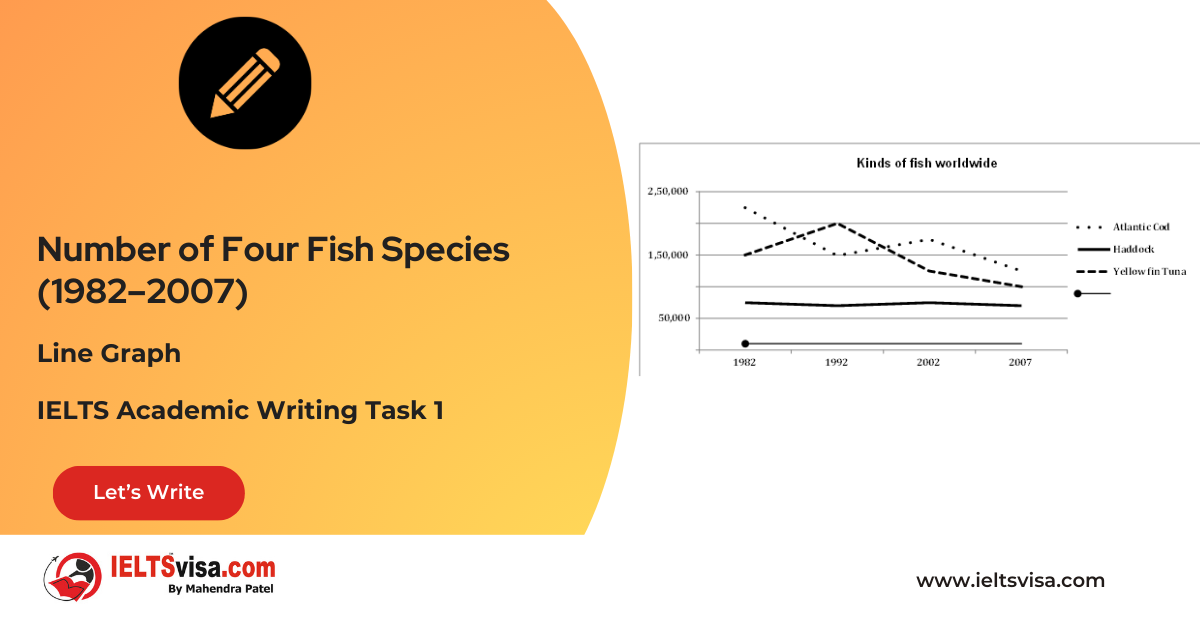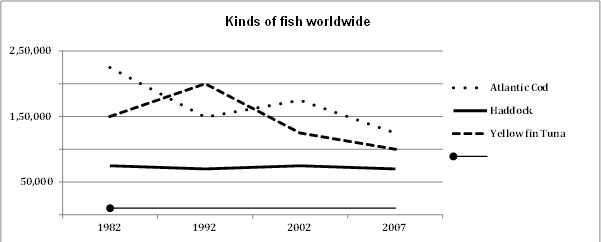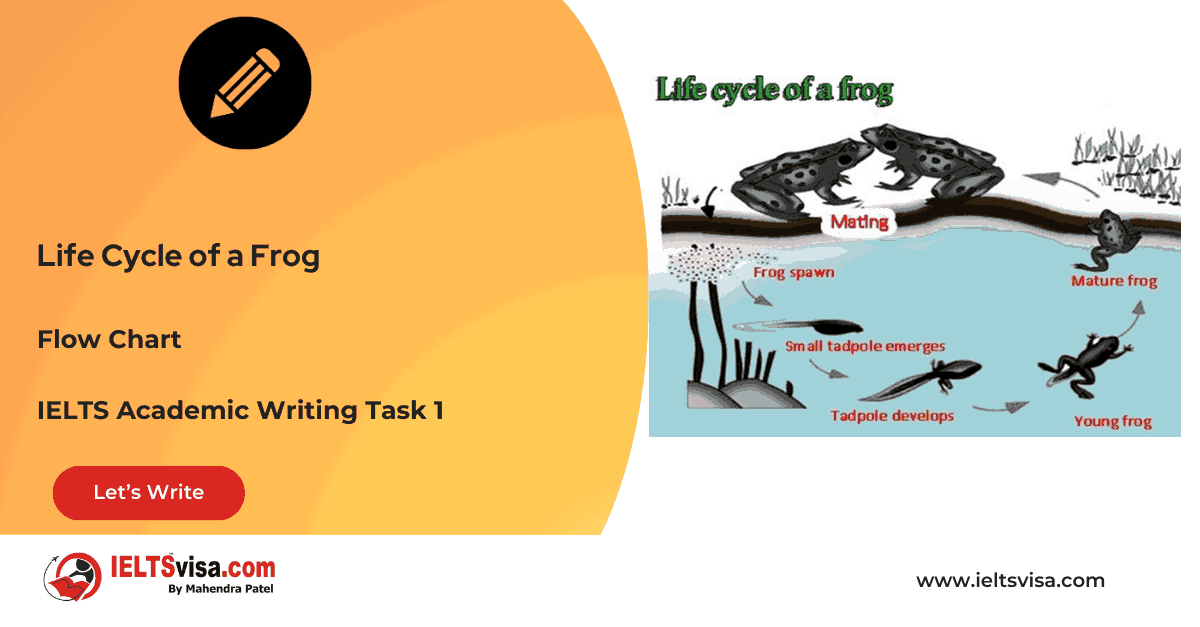Number of Four Fish Species (1982–2007)
IELTS Academic Writing Task 1 - Line Graph
IELTS Writing Task 1 Question
The chart below shows the number of four different species of fish between 1982 and 2007.

Common questions for the chart on fish species
1. Graph Type: Line graph
2. Title: Number of Four Fish Species (1982–2007)
3. What are the units of measurement?: Number of fish (in thousands)
4. Who: The fish species compared are Atlantic Cod, Yellow-fin Tuna, Haddock, and Swordfish.
5. When: Data spans from 1982 to 2007.
6. Where: The chart focuses on the population trends of these fish species (location unspecified).
7. Topic: Trends in fish species population over time
Process Showing and Trends
Comparison 1 : Atlantic Cod and Yellow-fin Tuna
- Atlantic Cod started with a high population of 225,000 in 1982, but their numbers fluctuated, decreasing sharply to 150,000 by 1992, rising again to 175,000 by 2002, and falling back to 125,000 by 2007. In contrast, Yellow-fin Tuna experienced an increase from 1982 to 1992, surpassing the Cod, before declining after 2002 to 100,000 by 2007.
Comparison 2 : Haddock and Swordfish
- The Haddock remained stable, consistently around 75,000 throughout the 25-year period. Swordfish remained the smallest group with a steady population of around 10,000 throughout the period.
Sample Answer
The line graph compares the population numbers of four fish species—Atlantic Cod, Yellow-fin Tuna, Haddock, and Swordfish—over a 25-year period from 1982 to 2007.
Overall, while the Atlantic Cod and Yellow-fin Tuna populations showed significant fluctuations, the Haddock and Swordfish populations remained largely unchanged over the period.
In 1982, Atlantic Cod had the highest population of 225,000, but this number dropped dramatically over the next decade, reaching approximately 150,000 by 1992. Afterwards, their numbers increased to 175,000 by 2002 before declining again to 125,000 by 2007. The Yellow-fin Tuna, which had fewer numbers than the Atlantic Cod in 1982, experienced a sharp rise until 1992, when it surpassed the Cod, but its population decreased thereafter, reaching 100,000 by 2007.
The Haddock maintained a stable population of about 75,000 throughout the entire period. Meanwhile, Swordfish remained in the minority, with numbers staying around 10,000 for the entire 25 years.
Top 25 Vocabularies
| Vocabulary | Meaning | Synonyms | Examples | Type |
|
Fluctuations |
Variations or changes in numbers |
Variations, oscillations |
“The population of Atlantic Cod fluctuated over the years.” |
Noun |
|
Surpassing |
To exceed or go beyond |
Exceeding, outstripping |
“The Yellow-fin Tuna surpassed the Atlantic Cod in numbers in 1992.” |
Verb |
|
Declined |
To decrease or become smaller in number |
Dropped, reduced |
“The number of Yellow-fin Tuna declined after 2002.” |
Verb |
|
Minority |
A smaller part or group |
Smaller group, less |
“Swordfish remained the minority species throughout the period.” |
Noun |
|
Steady |
Consistent or unchanging |
Stable, constant |
“The Haddock population remained steady throughout the years.” |
Adjective |
|
Variation |
A change or difference in condition or amount |
Alteration, shift |
“The population of Yellow-fin Tuna showed significant variation.” |
Noun |
|
Increase |
To become larger in amount, number, or degree |
Grow, rise |
“Atlantic Cod numbers increased to 175,000 in 2002.” |
Verb |
|
Decline |
A decrease in number, quality, or strength |
Drop, reduce |
“The population of Atlantic Cod declined after 2002.” |
Verb |
|
Peak |
To reach the highest point |
Reach, culminate |
“The Yellow-fin Tuna peaked in 1992, surpassing the Cod.” |
Verb |
|
Dramatic |
Having a great and noticeable effect |
Striking, significant |
“The decline in Atlantic Cod was quite dramatic.” |
Adjective |
|
Stable |
Fixed, unchanging, or constant |
Steady, consistent |
“Haddock’s population remained stable over the 25-year period.” |
Adjective |
|
Fluctuate |
To change irregularly or vary widely |
Vary, oscillate |
“The population of the Yellow-fin Tuna fluctuated after 1992.” |
Verb |
|
Surpass |
To exceed or go beyond a certain limit or level |
Outstrip, exceed |
“The Yellow-fin Tuna surpassed the Atlantic Cod in population.” |
Verb |
|
Minority |
A smaller portion or part of a whole |
Smaller group, less |
“Swordfish was in the minority throughout the entire period.” |
Noun |
|
Consistent |
Always behaving or happening in the same way |
Steady, uniform |
“The Swordfish population remained consistent over the years.” |
Adjective |
|
Persist |
To continue firmly or obstinately |
Continue, endure |
“Swordfish persisted in maintaining a low population.” |
Verb |
|
Remain |
To stay in the same place or condition |
Stay, continue |
“Haddock remained stable at 75,000 throughout the years.” |
Verb |
|
Oscillate |
To swing back and forth or vary between extremes |
Fluctuate, waver |
“The numbers of Yellow-fin Tuna oscillated between 1992 and 2007.” |
Verb |
|
Sharp |
Having a strong or intense quality |
Significant, steep |
“Yellow-fin Tuna showed a sharp rise in population until 1992.” |
Adjective |
|
Subsequent |
Coming after something in time or order |
Following, succeeding |
“The subsequent decline in Yellow-fin Tuna numbers was evident.” |
Adjective |
|
Relatively |
In comparison with something else |
Comparatively, somewhat |
“The Swordfish population was relatively low throughout the years.” |
Adverb |
|
Considerable |
Large in size, amount, or degree |
Significant, substantial |
“The increase in Yellow-fin Tuna was considerable by 1992.” |
Adjective |
|
Trend |
A general direction or tendency |
Pattern, movement |
“The trend shows a steady decrease in Atlantic Cod over time.” |
Noun |
|
Proportion |
A part or share of the whole |
Fraction, percentage |
“The proportion of Haddock stayed unchanged.” |
Noun |
|
Sharpness |
The quality of being intense or severe |
Intensity, strength |
“The sharpness of the Atlantic Cod’s decline was evident.” |
Noun |

Our Books
Master IELTS Speaking Part 1
IELTS Writing Task 1 Book
IELTS Writing Task 2 Book
Practice IELTS Other Modules
IELTS Listening
The IELTS Listening test assesses how well you can understand spoken English in various contexts. It lasts about 30 minutes and is divided into four sections with a total of 40 questions. The listening tasks become increasingly difficult as the test progresses.
IELTS Academic Reading
The IELTS Academic Reading section assesses your ability to understand and interpret a variety of texts in academic settings. It is designed to evaluate a range of reading skills, including skimming for gist, reading for main ideas, reading for detail, understanding inferences, and recognizing a writer's opinions and arguments.
IELTS Speaking
The IELTS Speaking test assesses your ability to communicate in English on everyday topics. It lasts 11-14 minutes and consists of three parts: introduction, cue card, and a discussion based on the cue card topic.
IELTS General Reading
IELTS General Reading tests your ability to understand and interpret various types of texts. Here are some key areas and types of content you can expect to encounter in the reading section, along with tips for effective preparation.
IELTS Academic Writing Task 1
In IELTS Academic Writing Task 1, you are presented with a visual representation of information, such as graphs, charts, tables, or diagrams, and you are required to summarize, compare, or explain the data in your own words.
IELTS General Writing Task 1
In IELTS General Writing Task 1, you are required to write a letter based on a given situation. The letter can be formal, semi-formal, or informal, depending on the prompt. Here’s a breakdown of the key components to include in your letter
IELTS Academic Writing Task 2
In IELTS Academic Writing Task 2, you are required to write an essay in response to a question or topic. Here’s a guide to help you understand the essential elements of this task
IELTS Exam Tips
To succeed in the IELTS exam, practice regularly, familiarize yourself with the test format, improve your vocabulary, develop time management skills, and take mock tests to build confidence.
Grammer for IELTS
Grammar is the foundation of effective communication in English. Understanding tense usage, subject-verb agreement, and sentence structure enhances clarity and coherence in writing and speaking.
Vocabulary for IELTS
Vocabulary plays a crucial role in the IELTS (International English Language Testing System) exam, especially in the Speaking and Writing sections. Here’s an overview of why vocabulary is important and how it impacts your performance
RECENT IELTS SAMPLES QUESTIONS AND ANSWERS
Task 1 – Diagram – Comparison of Stone Tool Development Over Time
20:00 Start Pause Stop [df_adh_heading title_infix="IELTS Writing Task 1 Question" use_divider="on"...
Task 1 – Flow chart -Life Cycle of a Frog
20:00 Start Pause Stop [df_adh_heading title_infix="IELTS Writing Task 1 Question" use_divider="on"...
Task 1 – Flow chart -The process that is used to manufacture bricks for the building industry.
20:00 Start Pause Stop [df_adh_heading title_infix="IELTS Writing Task 1 Question" use_divider="on"...
Task 1 – Map – Changes that took place in Youngsville in New Zealand over a 25 year period from 1980 to 2005.
20:00 Start Pause Stop [df_adh_heading title_infix="IELTS Writing Task 1 Question" use_divider="on"...
Task 1 – Pie Chart – The average household expenditures in Japan and Malaysia in the year 2010
20:00 Start Pause Stop [df_adh_heading title_infix="IELTS Writing Task 1 Question" use_divider="on"...
Task 1 – Bar Graph – The different modes of transport used to travel to and from work in one European city in 1960, 1980 and 2000
20:00 Start Pause Stop [df_adh_heading title_infix="IELTS Writing Task 1 Question" use_divider="on"...













